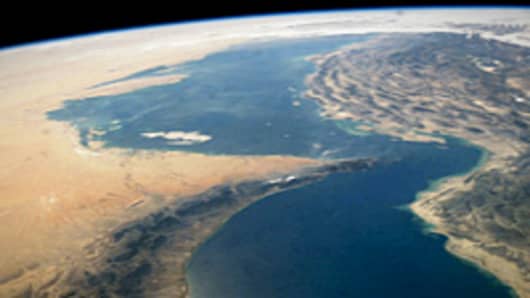Can Iran close the Strait of Hormuz? The anxious exchange of statements and explicit threats between the U.S. and Iran mark a notable escalation and leave the energy markets struggling to understand the implications.
U.S.-Iran relations have been strained for decades, but with the Arab Spring the region is already undergoing momentous political shifts.
There has always been a lot at stake. Iran is the second largest Organization of the Petroleum Exporting Countries producer, exporting 2.5 million barrels per day and holding over 150 billion barrels in proven reserves.
But it also, together with Oman, helps oversee the Strait of Hormuz, a shipping lane bottleneck that sees through some 17 million barrels per day of crude oil, close to 20 percent of global demand.
At its narrowest, the Strait is 21 miles wide, but there are only two traffic lanes, each two miles wide, one for inbound and the other for outbound traffic.
Last week, Iranian Vice-President Mohamad Reza Rahimi warned that no oil would be allowed to pass through the Strait of Hormuz if the West applied sanctions on oil exports.
The threat to close the Strait, whether or not in response to sanctions, has been of interest for some time.
A study by Caitlin Talmadge in International Security in 2008 suggested Iran “does possess significant littoral warfare capabilities” and “could halt or impede traffic in the Strait of Hormuz for a month or more.”
A year earlier, however, Anthony Cordesman of the U.S.-based Center for Strategic and International Studies argued “Iran could not close the Gulf for more than a few days to two weeks even if it was willing to suffer retaliation,” including the loss of oil facilities and related revenues.
The only major alternative outlet for some of the Gulf crude oil would be through the Saudi Arabian to port of Yanbu on the Red Sea, limited to roughly five million barrels per day.
In 2010, Peter Pham presented the case in American Foreign Policy Interests, saying although the Iranian threat in the Strait of Hormuz should “not be dismissed, it is not cause of alarm” vis-à-vis the expected consequences of retaliation.
Indeed, the use of its own oil as a bargaining tool could backfire, given that the Iranian government is dependent on oil exports for more than 50 percent of its revenues.
With all the oil that passes through the Strait, a broader closure would spark outrage not just among some of Iran’s major oil customers, but from all those reliant on the oil exports of Gulf states, as well.
On Wednesday, Iran's Foreign Ministry Spokesman Ramin Mehmanparast entirely dismissed the threats of broader oil sanctions on Iran, saying that the West was “incapable of removing Iran from energy transactions.”
A standoff between the U.S. and Iran already took place in 2007-2008 between Iranian speedboats and U.S. Naval warships. The last conflagration came in 1988, when U.S. forces launched Operation Praying Mantis.


